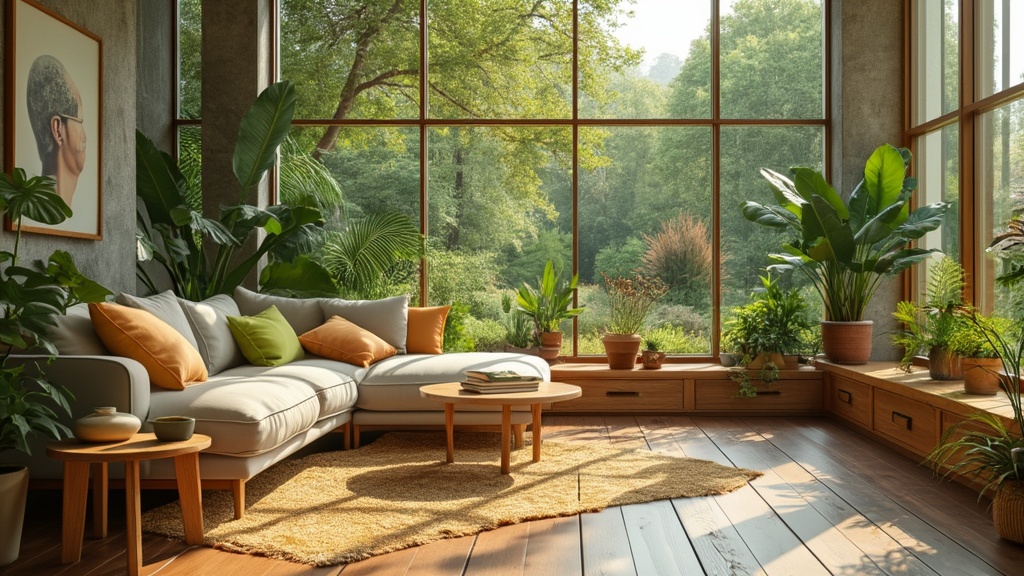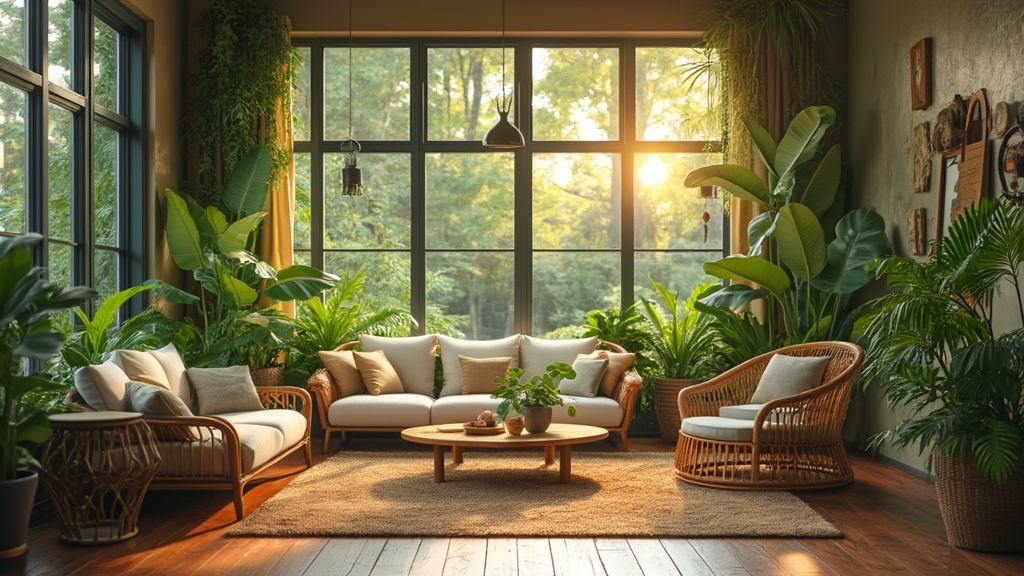Innovative ecofriendly furniture provides remarkable changes to modern living spaces. Choosing ecofriendly options not only beautifies your home but also significantly contributes to environmental preservation and personal well-being.
Designed with sustainable materials, these pieces infuse homes with a sense of purpose, showcasing aesthetic appeal while prioritizing ecological conservation.
Informed decisions about home decor enhance indoor air quality, ultimately promoting healthier living environments.
By integrating ecofriendly furniture into your home, you embark on a journey toward conscious consumption, making a meaningful impact on both your surroundings and lifestyle.
Click here to learn more about: interior designers and decorators
Sustainable Materials in EcoFriendly Furniture
Effective sustainable materials form the backbone of ecofriendly furniture, ensuring a minimal ecological footprint. These materials significantly reduce volatile organic compounds (VOCs), enhancing indoor air quality and contributing to better health outcomes.
For beginners, several common options exist: Bamboo furniture, a rapidly renewable resource, stands out for its strength and sustainability.
Reclaimed wood, sourced from old furniture or buildings, decreases waste while adding unique character to pieces.
Additionally, organic cotton, grown without pesticides, offers softness and safety for consumers.
Cork, harvested sustainably, resists mold and mildew, proving to be an excellent choice in ecofriendly design.

What Is Recycled Furniture
Recycled furniture serves as a sustainable solution to the problem of furniture waste. This process begins with the collection of old furniture from various sources, including homes, offices, and thrift stores.
Typically, skilled artisans refurbish these items, a process that involves stripping paint, repairing damage, and applying new, environmentally friendly finishes.
This furniture recycling method significantly reduces contributions to landfills, helping to conserve natural resources and reduce pollution.
Notably, brands like Reclaimed Wood Furniture make effective use of salvaged materials, exemplifying environmentally friendly practices. By repurposing existing resources, recycled furniture not only promotes resource conservation but also provides unique pieces, each with its own story, appealing to ecoconscious consumers who seek organic design options.
Benefits Of Nontoxic Finishes
Choosing nontoxic finishes plays an integral role in creating a healthy indoor environment.
These finishes are free from harmful chemicals, which significantly enhances indoor air quality and reduces risks associated with allergies and respiratory issues. The connection to sustainable materials is strong, as safe finishes complement eco-friendly furniture choices.
To identify nontoxic options while shopping, consumers should actively look for certifications such as GREENGUARD or VOC-compliant ratings.
Visiting reputable retailers that prioritize sustainable practices can streamline the purchasing process.
By emphasizing health-conscious furniture, consumers not only enhance the longevity of their furnishings but also empower themselves to make informed, eco-friendly decisions.
Recycled Furniture and Nontoxic Finishes
- Recycled furniture can reduce landfill waste by up to 70%, significantly minimizing environmental impact.
- Nontoxic finishes can improve indoor air quality by reducing volatile organic compounds (VOCs) by up to 90%.
- Using reclaimed materials for furniture can save approximately 20 million trees annually, contributing to forest conservation.
- Eco-friendly furniture choices often lead to a 30% reduction in energy consumption during production processes.
Exploring Organic Design Principles
Organic design principles create a harmonious link between sustainable living and furniture choices by emphasizing natural aesthetics. These designs utilize sustainable materials, ensuring that the products not only look appealing but also contribute to environmental health.
Incorporating forms inspired by nature, organic design enhances aesthetic appeal through its flow and grace, fitting seamlessly into various home styles, from minimalist decor to rustic.
Organic design invites nature into our living spaces, transforming interiors with its calming presence.
One exemplary piece of organic design is Eero Saarinen’s Tulip Table, which showcases a sculptural base made from cast aluminum and a durable laminate top.
This iconic furniture piece illustrates how aesthetic appeal and innovative materials can coexist, championing both beauty and sustainability in home decor.
How Green Living Influences Furniture Choices
Green living continues to reshape consumer preferences regarding furniture purchases.
An increasing number of shoppers prioritize sustainable materials, including bamboo furniture and reclaimed wood, for their eco-friendly properties and aesthetic value. The demand for nontoxic finishes, such as low-VOC paints, is also rising, as consumers prioritize health and indoor air quality.
Statistics reveal that a significant percentage of shoppers now opt for eco-friendly options, reflecting a shift towards conscious consumption.
A practical tip for consumers is to research certifications, like LEED certification, ensuring the products align with sustainable practices.
By choosing locally sourced and handcrafted furniture, consumers not only support the environment but also nurture their local economies.
Organic Design and Green Living
- Organic design prioritizes the use of sustainable materials, contributing to environmental health.
- Shoppers increasingly prefer eco-friendly furniture options, with a notable rise in demand for bamboo and reclaimed wood.
- Low-VOC paints and nontoxic finishes are becoming popular as consumers focus on improving indoor air quality.
- Researching certifications like LEED ensures that furniture choices align with sustainable practices.
The Appeal Of Bamboo Furniture
Bamboo furniture represents a remarkable fusion of beauty and sustainability. As one of the fastest-growing plants globally, bamboo can grow up to 3 feet in a single day, making it an incredibly renewable resource.
Its natural pest resistance and moisture resilience contribute to its durability while enhancing its adaptability for various design styles.
Both indoor and outdoor applications benefit greatly from bamboo’s inherent strength paired with its lightweight nature.
To ensure the longevity of your bamboo furniture, regularly dust surfaces and apply a bamboo-specific oil occasionally.
This simple maintenance step will help preserve its natural aesthetics while preventing drying out. Embracing bamboo furniture aligns perfectly with eco-conscious lifestyles, promoting green living without sacrificing style.
Advantages Of Reclaimed Wood Usage
Reclaimed wood serves as a prime example of how sustainability can be integrated into modern design.
This approach significantly enhances furniture waste reduction, reducing the need for new materials and minimizing deforestation. By repurposing existing materials, reclaimed wood promotes a circular economy where resources are reused effectively.
Each piece of reclaimed wood carries its own history and character, offering a distinct aesthetic appeal that can positively enhance any interior space.
When considering reclaimed wood furniture, prioritizing proper treatment and inspection for pests or decay is essential.
This practice helps maintain its structural integrity, ensuring both safety and longevity.
Engaging with this sustainable design approach contributes to a more environmentally responsible lifestyle while adding unique charm to your home.
Bamboo Furniture and Reclaimed Wood
- Bamboo can grow up to 3 feet in a single day, making it one of the fastest-growing plants.
- Using reclaimed wood significantly reduces furniture waste and minimizes the need for new materials.
- Bamboo’s natural pest resistance and moisture resilience enhance its durability for various design styles.
- Each piece of reclaimed wood has a unique history, adding distinct character and charm to any space.
What Are Biodegradable Products In Furniture
Biodegradable products encompass materials that naturally decompose, significantly contributing to a reduction in landfill impact. These materials play a key role in limiting the environmental toll of furniture production, which has a reputation for generating substantial waste.
Definition of Biodegradable Materials
- Biodegradable materials are substances that break down naturally through the action of microorganisms.
- This decomposition process is essential for reducing non-biodegradable waste in landfills.
Significance in Furniture Design
- The utilization of biodegradable materials encourages sustainable practices throughout furniture manufacturing.
- Natural materials enhance the aesthetic appeal of living spaces while promoting environmentally friendly practices.
Example of a Biodegradable Product
- Bamboo furniture serves as an exemplary product, known for its durability, aesthetic richness, and sustainability.
- This material offers additional benefits, including being lightweight, versatile, and a rapidly renewable resource.
Biodegradable Products in Furniture
- Biodegradable materials can decompose within months to a few years, unlike traditional materials that can take decades.
- Using biodegradable products in furniture can significantly reduce carbon footprints associated with manufacturing and disposal.
- Incorporating biodegradable materials can enhance the marketability of furniture by appealing to environmentally conscious consumers.
- Studies show that sustainable furniture options can lead to increased customer loyalty and brand reputation.
Biodegradable Furniture Materials Inspire Sustainable Living



